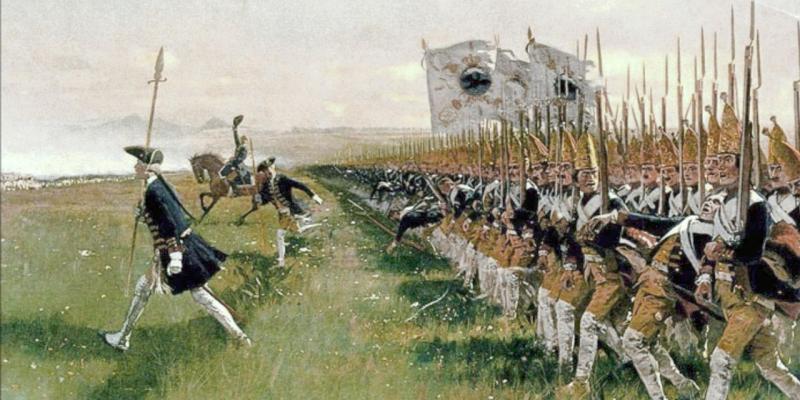'Iron and Blood' Review: The German Way of War
By: William Anthony Hay (WSJ)



Field Marshal Bernard Montgomery, Britain's fabled World War II general, purportedly remarked that you haven't truly experienced war until you have fought the Germans. Whether or not he used those words, the sentiment captures a common view—that Germany is a uniquely militaristic nation. Even Germany's post-1989 rejection of war and insistence on being a "civilian power"—part of its official creed—buttressed this framing of the past. What other country would feel the need to redefine itself in such a way?
Germans, the story goes, have long shown a predisposition to aggressive war, though many reasons for their belligerence have been advanced over the years: a fear of encirclement, a lack of easily defended borders, a hostile neighborhood, the burdens of balance-of-power leadership. For many, Germany is a kind of caricature: a nation that was unified in the late 19th century by militant Prussia (bristling with soldiers and discipline) and that, in the 20th, launched two world wars that ended in total defeat.
In “Iron and Blood,” Peter Wilson, a professor at Oxford, is eager to widen our perspective and avoid simple determinism or reductive stereotype. Blending narrative overview with thematic analysis (of weapons, organization and the culture of war), he argues, among much else, that to see Germany as preternaturally belligerent—and thus susceptible to authoritarianism like no other modern state—is to exclude much of Germany’s complex history.
The traditional view, Mr. Wilson notes, imposes a template on German history that came into being only after 1866, when Prussia took key German states away from Austria and set the stage for the Franco-Prussian War of 1870 and Germany’s post-victory unification. He reaches back, instead, to the 16th century to trace the military history of “the German-speaking peoples” up to the present day. It is a fascinating history in itself and reminds us just how much war shaped modern Europe.
For centuries, the heart of the German-speaking peoples was the Holy Roman Empire—the powerful amalgam of states and principalities ruled by the Habsburg dynasty. At a time when France, Spain and England emerged as centralized nation-states—inaugurating the period known as Early Modern Europe—the Holy Roman Empire resisted consolidation. The Habsburgs ruled a third of the empire directly, but for the rest required cooperation from other princes. The empire’s lands reached from the Rhineland to Bohemia and included, at times, the Low Countries as well as Switzerland
Mr. Wilson emphasizes that imperial power was widely dispersed, with peace taken to be the normal condition and war the unwelcome exception. The office of Kriegsherr, held by princes, didn’t indicate a warlike society but identified “a legitimate political authority,” Mr. Wilson says, one that could indeed wield military power but not necessarily use force to exercise arbitrary control. Militarism “was neither an end destination nor a single trajectory of development.”
Habsburg power grew exponentially under Maximilian I and Charles V, who used it to check internal conflict. Indeed, the Peasants’ War (1524-25) was Germany’s last popular revolt before 1848. Even the religious upheaval emerging from the Protestant Reformation generated less conflict in the lands of the Holy Roman Empire than elsewhere. That is not to say that German soldiers adopted a bystander role. Princes routinely hired out their troops (admired for their courage and skill) to other states: Swiss pikemen, for example, fought for France and Spain. Such “foreign” service, Mr. Wilson says, gave soldiers battlefield experience that honed tactics and improved effectiveness.
For Mr. Wilson, it is the Thirty Years’ War (1618-48) that ushered in the first era of German militarism. This civil war within the empire was triggered by Protestant princes seeking autonomy from Vienna, if not separation. The strife began in Bohemia, where the emperor won an early battle and reimposed Catholicism. But the fighting see-sawed for years, each side overreaching and outside powers entering the fray. The frequent inability of rulers to pay their troops and supply them led to pillage and plunder—so-called free quarter—heightening the war’s brutality and devastation. Eventually peace came, in the form of the Treaty of Westphalia, confirming the autonomy of the princes.
More important, for the arc of Mr. Wilson’s argument, is the growth of professional armies in these decades. Traditionally fighting forces had been recruited when needed and then demobilized. Now rulers formed standing armies paid for by taxes and disciplined with training and drill—of necessity: Gunpowder weapons had to be fired in coordinated volleys, since they took time to reload and couldn’t be aimed precisely. Fighting together required professional training and leadership.
But the empire faced multiple threats, so no one way of war would suffice. The great enemy in the 17th century was the Ottoman Turks, who were famously repelled in 1683 in the epic Siege of Vienna. Fighting in the mountainous Balkans had demanded improvisation and irregular warfare. That said, the Habsburgs generally adopted a cautious or defensive strategy, never risking an entire army in a bold forward thrust but rather relying on fortresses, roads and natural defenses (mountains, rivers) for falling back, as needed, and aiming to wage war over time. Prussia, by contrast, with fewer people, less wealth and no natural defenses developed a war doctrine to score quick victories—striking hard and shocking the enemy.
Prussia emerged as a force in the late 1600s, though Austria remained the dominant power until well after 1815. Frederick II, whose exploits did so much to bring Prussia military fame, sought to emulate the audacity of his heroes—most notably Alexander the Great—by invading Silesia in 1740 when Maria Theresa came to the Austrian throne. His “front-loaded” strategy relied on decisive early victory to avoid protracted conflict. Another round of fighting soon came in the Seven Years’ War, though it ended up putting Frederick on the defensive and nearly bringing defeat. Occasional brilliant campaigns hid the degree to which Prussian success rested on wider circumstance—the support of allies and foreign financing, for instance. Even Frederick determined never to take such risks again.
It is the French who, in the 18th and early 19th centuries, vexed the “German-speaking peoples” and a lot of other peoples as well. The wars following the French Revolution as well as the Napoleonic Wars put the Habsburgs and their allies at a disadvantage. In France, conscription—total mobilization—enabled especially aggressive tactics, and Napoleon recruited manpower (as well as financing) from outside France, to good effect. He abolished the Holy Roman Empire in 1806, made the Rhineland states into a French satellite, and reduced a vanquished Prussia to a secondary rank.
Mr. Wilson notes how the Austrian Joseph Radetsky developed an attritional strategy to defeat Napoleon’s subordinates and weaken the French position. Among German powers, especially Prussia, the defeats and setbacks of the Napoleonic era goaded armies to rebuild and rethink. (The Prussian strategist Carl von Clausewitz built his theory of war in part on the experience of fighting the French.) French defeat in Russia and massive British aid brought about the War of Liberation (1813-15) that drove Napoleon from Germany and ultimately from power. The German Confederation, led by Austria and Prussia, replaced the empire in 1815. With the lessons of the French Revolution everywhere in mind, soldiers after 1815, Mr. Wilson notes, became “guardians of order prepared to crush internal opposition.”
The Austro-Prussian War of 1866 knocked the Habsburgs out of Germany, and the Franco-Prussian War in 1870, culminating in the capture of Paris, led to the proclamation of a new German Empire under Prussia. German unification, Mr. Wilson says, disrupted the European balance of power, and a sense of vulnerability underlay the triumphalism of victories won by “iron and blood,” in Bismarck’s phrase. Germany simply could not sustain a long “people’s war”; it had to win quickly and decisively. It was the Prussian way of war in any case.
The two world wars produced exactly the type of protracted conflict that German leaders had long feared—first with Alfred von Schlieffen’s reckless (and failed) scheme to conquer France rapidly in 1914 before turning east against Russia; then, a generation later, with Hitler’s Blitzkrieg tactics, seemingly invincible in 1940 but soon enough meeting catastrophe in Russia. Successful campaigns and innovative tactics hid the lack of strategic thinking needed to secure political aims. In both wars, military necessity counted more than civilian oversight or international law.
Total defeat in 1945 exposed the fallacy of Germany’s military genius, but Mr. Wilson’s fascinating and comprehensive chronicle reminds us that the country’s vaunted reputation was of recent vintage anyway and failed to encompass the many Germanic traditions that had little to do with Prussia, which was dominant for only a limited period. Recovering the complexity of German military history gives us a fresh perspective—one that is especially welcome at the current moment, when Germany is debating what its role should be as cannons fire and bombs drop yet again in Europe.



